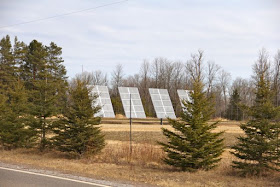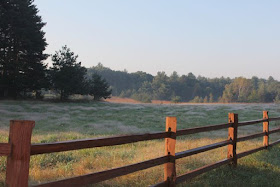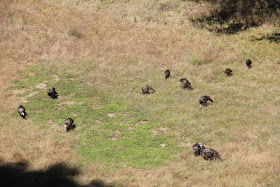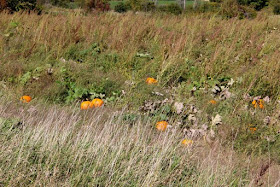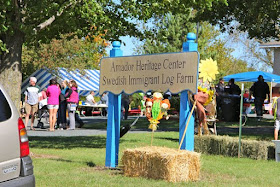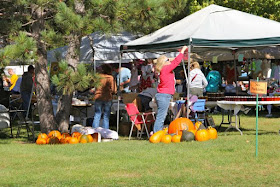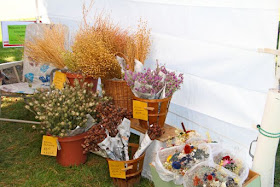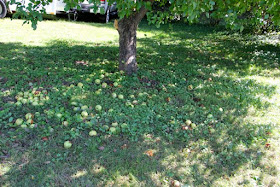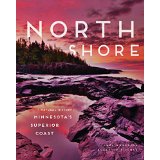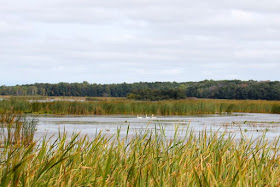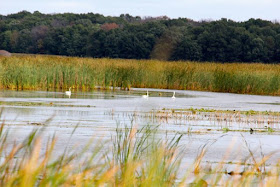By the looks of the low spot behind the house, we might have experienced a micro-climate frost this morning. I can see sun shining less than 20 feet uphill from what looks like frost-whitened grasses. Our low temperature, at a slightly higher elevation, was in the mid-30s, so I can believe there might have been a "soft" frost, or not. Since our average first frost usually occurs within the next ten or twelve days, we seem to be generally on schedule.
wind farm, southwestern Minnesota
Photo by J. Harrington
Yesterday, I mentioned coming across a reference to a desire for a sketch of more sustainable Minnesota. Later, as I was walking the dogs, I finally remembered where I had seen it (confirming the theory that a good way to remember something is to not think about it). Specifically, Scott Strand, ED at the Minnesota Center for Environmental Advocacy, blogged "we need some kind of honest shared visualization of what a decent future looks like" in regard to climate change, air pollution and water pollution. Keep in mind William Gibson's observation that "The future is already here — it's just not very evenly distributed." (To which I would add: "nor is it being well tended to.") Much of what we can sketch of a future has been around for a while, in one form or another, just not very evenly distributed.
I wouldn't presume to offer a fully developed, shared solution, but I'm foolish and hardy enough to sketch out some of my thoughts and see if they generate any kind of response. If enough folks like any of the ideas presented, we get to the beginning of a shared vision. In polite circles this is referred to as the start of a dialogue, or, even better, a conversation, something sadly lacking in most of our political discourse these days.
Since I'm a firm believer that everything is related to everything else, some things more directly than others, I'm going to start by suggesting we need to start our conversation from a premise that we need to do more systems thinking, including better and more frequent use of integrative design as an an ongoing process for creating and implementing our vision. We need to focus on solutions that do good instead of settling for doing less bad (Cradle to Cradle). We need to seriously incorporate the four Natural Step system conditions for a sustainable society into our conversations. Those are the ultimate system constraints we're faced with. Here's an example that begins to respond to the climate change and air particulates concerns Scott raised.
solar panels, northeastern Minnesota
Photo by J. Harrington
ENERGY VISION: In the foreseeable future, Minnesota will become free from using fossil fuels and will be powered solely by distributed energy, generated primarily from renewable energy sources, such as solar and wind, at community-based networked facilities. Electric car batteries and related storage technologies will play an increasing role as supplemental sources.(The internet, and its development, is a "mental model" for this kind of system.) To achieve this vision, Minnesota will need to change its Public Utilities Commission's mindset and decision-making processes, not easy but doable. We will also need to revise or eliminate zoning or land use controls that would inhibit neighborhood energy facilities. Attaining this vision will be a major response to climate change and, by ultimately eliminating the need for and use of diesel engines, will eventually eliminate a major source of fine air particulates. Creating, installing, maintaining and replacing our energy system over time will create many new types of jobs, so the state's universities and community and technical college systems will need to work with existing businesses and entrepreneurs. Significant changes in the way society underwrites and finances power production and transmission facilities will be needed, creating opportunities for risk sharing, job creation and new sources of profit for Minnesota's financial sector. Minnesota's Iron Range could become a leadership center, through creative partnerships, that develops, tests and adapts electric power technology for heavy industrial and agricultural and, ultimately, over-the-road use. That's not a complete picture, but it's a start. We can take a similar approach to other systems, food production being another example. Our purpose here isn't to get everything perfect as we sketch scenarios. Those details can come later. Let's see if we can take the proverbial "broad brush" and paint some kind of picture of the future we'd like, instead of spending as much energy as we do fighting about what we don't agree about. Since the US military acknowledges that climate change presents national security threats, maybe some creative, political soul could successfully approach DARPA for funding of some parts of this system.
[UPDATE: Several hours after today's blog posting was uploaded, the guardian published the story linked below, which reads to me like an argument for replacing our current generation / transmission system.
World's energy systems at risk from global warming, say leading firms
Lines from the Reports of the Investigative Committees
The Department of the Interior and Department of Homeland Security announced a joint enquiry into the explosion and sinking of the Transocean Deepwater Horizon on April 22. The us House of Representatives Committee on Energy and Commerce Subcommittee on Oversight and Investigations and Senate Committee on Energy and Natural Resources have also announced investigations.
Last week bp launched its own investigation into the incident and has an investigation team at work in Houston, Texas.—bp.com, April 28, 2010
Beneath three thousand feet, the sea is wholly dark.The shuttle feeds hydraulics to the blind shear ramand represents a single failure point for disconnect.Recommendation: Declare selected points on earthinvisible. Affected communities have been providedwith limited quantities of powdered milkand other staples. Many questions remain. Someclose their eyes under water instinctively.Imagination can create a sense of peril whereno real peril exists. Safety equipment testswere necessarily imaginary; mechanisms in questionwere wholly inaccessible. A journalist sinkinginto the mud was told to toss his camerato a colleague and hold extremely still. In thissense, we are our own prisoners. Investigatorshave salt in their hair and sand in their teeth.The hotel pool is empty. Yet questions remain.Barbeque billboards depict grinning pigs in apronsand toques. Cleanup crews recover thousandsof plastic milk jugs from the shallows. Do theseimages appeal to the death drive? Care should betaken to ensure the highest possible reliabilityfrom that valve. Thousands in affected communitieshave been evicted and live in tents. Demonstratorshave prevented investigators from accessinghotel stairwells. 1900: Rudolf Dieseldemonstrates an engine fueled by peanut oilat the Paris World’s Fair. The Vietnamese ownerof Bad Bob’s bbq Buffet tells a journalistshe last drank powdered milk in a refugee camp“a thousand years ago.” Items available onlyin limited quantities are found in Appendix C.Cleanup crews have stacked thousands of drumsof dispersant in hotel parking lots. Dominantfailure combinations for well control suggestadditional safety mechanism diversityand redundancy provide additional reliability.Bank of America will offer limited foreclosuredeferments in affected communities. Thousandsof years ago, a pronghorn ram slipped beneaththe surface of a tar pit, jerking its snoutfor air. Recommendation: Live at inaccessibleelevations. Recommendation: Close your eyes.Recommendation: Prevent access to the invisible.Engineering reports noted required safetymechanisms were unlikely to function yet wererequired for safety’s sake. If the committeemay offer an analogy, a blind surgeon is dangerous,an imaginary surgeon harmless. Still, questionsremain. BP’s 2010 Q1 replacement cost profitwas $5,598 million, compared with $2,387 milliona year ago, an increase of 135%. Unlimitedquantities of peanuts are available. However,care must be taken to ensure continued highreliability of the shuttle valve, since it isextremely critical to the overall disconnectoperation. Phenomena not meant to be accessedor imagined are found in Appendix E. Cleanup crewsare sometimes idled for lack of fuel. 1913: Dieselfound dead, drowned under suspicious circumstances.The investigators’ hotel toilets won’t flush.Midas turned everything he touched to gold.In this sense, seabirds cloaked in oil are rich.Cleanup crews live in tents and are providedwith limited quantities of barbeque and wearwhite canvas jumpsuits like prisoners on furlough.If the committee may offer an analogy, the deathdrive resides at wholly dark depths of imaginationand fuel issues from a wound we’ve opened there.
********************************************
Thanks for visiting. Come again when you can.
Please be kind to each other while you can.

